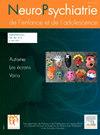Construire, déconstruire, reconstruire les souvenirs : l’inlassable tâche du patient en psychothérapie, l’indéfectible engagement du thérapeute ? À propos de quelques particularités dans l’accompagnement psychothérapique des enfants et des adolescents
Q4 Medicine
Neuropsychiatrie de l''Enfance et de l''Adolescence
Pub Date : 2025-01-01
DOI:10.1016/j.neurenf.2024.10.002
引用次数: 0
Abstract
Remembering, again and again, to solve the enigma of a symptomatic expression related to a burrowed suffering, such is the response of a more or less zealous neurotic patient to his or her psychoanalyst's implicit expectations. The stream of screen memories is churned out in a transference field of attraction and renders the suitable material to develop successive drafts of a “explanatory biography”. Traumatic memories which are the most present in the patient's memory often get their affective and emotional charge from an afterwardsness effect and invite one to pursue research in other regredient ways towards an older past. It is evident though that the therapist is not able to reach “pure memories”, and that in the course of time only “pivotal” memories show up around which fantasies spin and strengthen. Yet we know about Freud's persistence, even after he gave up on his “Neurotica” in “searching for the source of the Nile”, that is to say having access to the oldest memories, and how he hung onto his first conception according to which fantasies would only emerge from a previous experience. The constructions from the psychoanalyst, put together based on his theoretical bedrock, have thus the function of filling in the gaps of memory and in favourable cases allow the patient's associations to be revitalised and help the emergence of even more concealed memories. They are also supposed to be plausible hypotheses for the reconstruction of traces from a non-memorable past. Memories also contribute to forge a sense of identity and come within the scope of everyone's “identificatory compromise”. Consequently, the therapist's role could consist of supporting the work of the “I, historian” his patient is trying to make, taking into account the narratives from his kin, the noteworthy moments in the course of his life, and the way he cares about his self-image. It comes down to the therapist to help the patient with splitting off from the official versions which summon him to an incontestable place in the generations succession or in the family dynamics. In this perspective, the psychotherapeutic work aims to give value to the memories that might lead to new prospects but may encounter difficult obstacles to overcome. A child in psychotherapy is barely preoccupied by remembering the past, which does not prevent him from being sensitive to the fact that his therapist might make references to material from former sessions or remind him what was going on at the moment they met. A teenager's position is fundamentally different: he might not tolerate being relegated to the persistent role of the infantile when he is trying to be acknowledged in his teenage identity. He can, however, rediscover the pleasure of telling, portraying himself as the therapist suggests wordings and rewordings. Naturally, each case appears to be different from one teenager to another, depending on the underlying psychopathological organisation of their personality. Some of them seem to have no memory or to have wiped out the past, while others seem to be nostalgically shackled by an idealised childhood or are riveted to a painful past, everlastingly overwhelming. Thus, depending on the circumstances, the therapist will have to take on roles such as the prospector, the archivist, the re-interpreter, the historian or even the one who engages the process of a life history.
求助全文
约1分钟内获得全文
求助全文
来源期刊

Neuropsychiatrie de l''Enfance et de l''Adolescence
Medicine-Pediatrics, Perinatology and Child Health
CiteScore
0.60
自引率
0.00%
发文量
61
期刊介绍:
Organ of the Société française de psychiatrie de enfant et de adolescent, Neuropsychiatrie de enfance et de adolescence tackles all fields of child-adolescent psychiatry and offers a link between field and clinical work. As a reference and training tool for students and practitioners, the journal publishes original papers in child psychiatry as well as book reviews and conference reports. Each issue also offers a calendar of the main events dealing with the speciality.
 求助内容:
求助内容: 应助结果提醒方式:
应助结果提醒方式:


